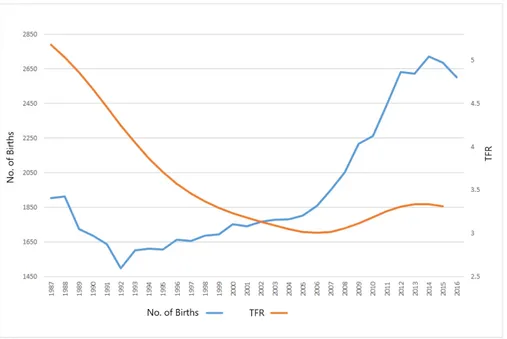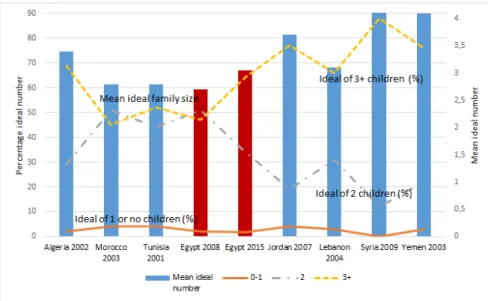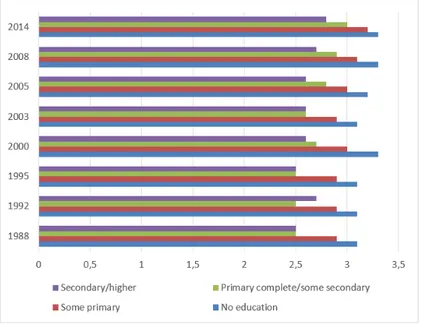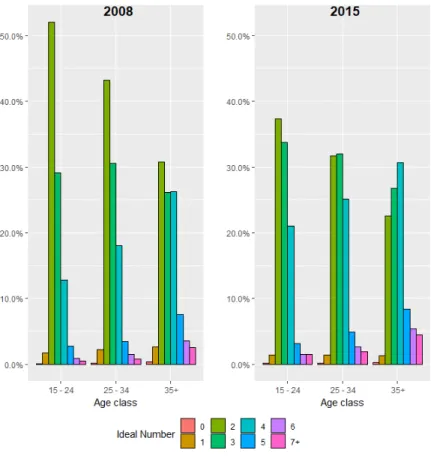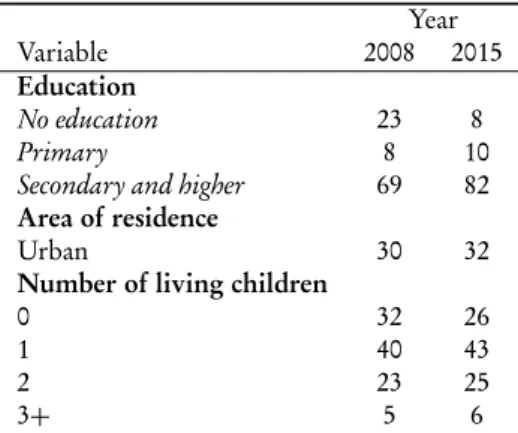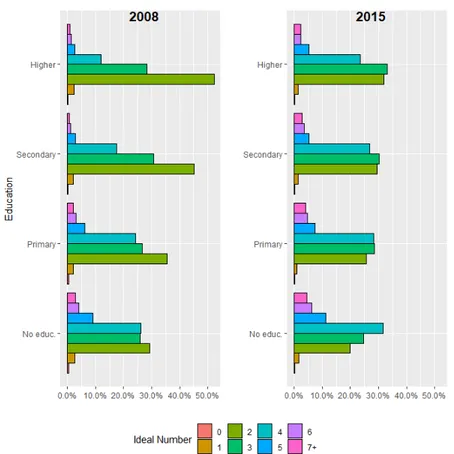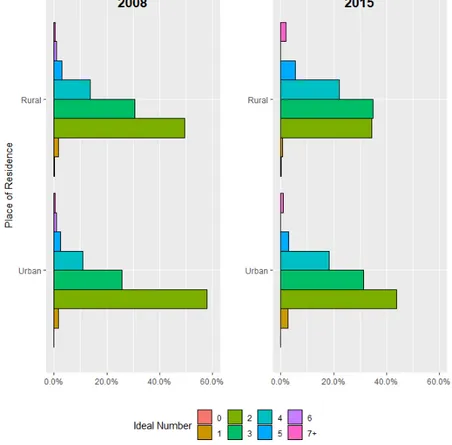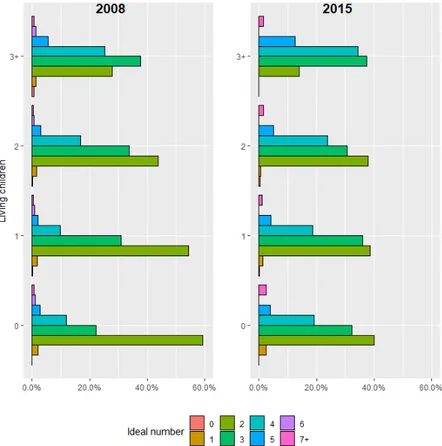IDEAL FAMILY SIZE AND FERTILITY IN EGYPT: AN
OVERVIEW OF RECENT TRENDS
Elena Ambrosetti
Dipartimento di Metodi e Modelli per l’Economia, il Territorio e la Finanza, Sapienza Università di Roma, Roma, Italia
Aurora Angeli
Dipartimento di Scienze Statistiche, Università di Bologna, Bologna, Italia
Marco Novelli1
Dipartimento di Scienze Statistiche, Università di Bologna, Bologna, Italia
1. INTRODUCTION
From 2012 to 2016 Egypt saw the birth of almost 2.6 million babies per year, accord-ing to the country’s statistics agency CAPMAS (CAPMAS, 2018). Data on Egyptian fertility show contradictory trends: the average number of children per woman (TFR) declined from 6.6 in 1990 to 3.0 in 2008 and then it raised to around 3.5 in 2014 (Fig-ure 1). General trends mask notable geographic differences recorded in the last decade: fertility fell in the urban Governorates while it raised in the rural ones. For example, the TFR in rural Upper Egypt reaches 4.1 children per woman in 2014 versus 3.6 in 2008 (UNICEF, 2015).
The country is already the most populous in the Arab world with 93 million citi-zens in 2016 and it sets to grow to about 120 million by 2030 if the same level of fertility will continue (United Nations, 2017). The dramatic demographic change is a national political issue in the country, and this was confirmed during the 4th National Youth
Conference held at the Alexandrina Bibliotheca on the 24thof July 2017 by President
Abdel Fattah El Sisi, who recognized terrorism and population growth as “the greatest two challenges Egypt is facing”. After El Sisi’s speech, the Ministry of Health and Popu-lation together with the Ministry of Social Solidarity announced a new family planning campaign: theItnein Kifaya (Two is enough). It aims at reducing the fertility rate from 3.5 children per woman to 2.4 by 2030 and it is addressed to poor households benefi-ciaries of theTakaful (Solidarity) Program, i.e. an income support program for families
with children (0–18 years). This new population policy is targeting rural areas where the fertility rate is particularly high and the program focuses on education and empower-ment of women as instruempower-ments to raise female awareness on the need to curb population growth.
Figure 1 – Number of births and TFR evolution in Egypt 1987-2016. Source: U.N. Population Division (https://population.un.org/wpp/DataQuery/) Accessed on July 2018.
It is worth noticing that, within the framework of a well-established tradition of fam-ily planning policies, for the first time the Egyptian authorities promoted, in an official policy, smaller families. The adoption of family planning policies began more than 60 years ago in Egypt with the distribution of contraceptive services to the population: as early as 1955 the first family planning clinics were opened, followed by the creation in 1976 of the Center for Information, Education and Communication (IEC). The Egyp-tian state’s population policy was first included in a plan of global development: this position was maintained until the early 1980s. According to Robinson and El-Zanaty (2006), the period 1985–1995 has been fundamental to the success of the Egyptian family planning program with the creation of the National Population Council and a better co-ordination and leadership of the program at the institutional level. In 1993, the creation of the Ministry of State for Population and Family Welfare symbolized the government’s concerns over population issues. The population has become a priority for the Egyptian government, with specific policies within the state and its institutions. USAID has been the major founder of Egyptian family planning programmes between 1977 and 2007.
However, in 2006 USAID funding was gradually phased out; since then the Ministry of Health and Population has been the major funders of family planning programmes. Since 2018 the Egyptian government has sought new alliances with USAID in order to strength Egypt family planning’ programme through the private sector with a total investment of more than $ 22 million (USAID, 2018). A body of research showed that attitudes towards ideal family size closely correlate with actual patterns of fertility (Penn and Lambert, 2002; Olenick, 1998). Moreover, ideal family size may be interpreted as a societal norm that is evolving together with major societal changes witnessed in a coun-try during the last decades. Previous studies have identified various personal and societal factors to explain differences and trends in the ideal number of children: e.g. cultural factors, education (Dyson and Moore, 1983), family influences and childbearing experi-ence of the older generations (Axinnet al., 1994), desired balance in gender composition for children (Bongaarts, 2001). Gender relations have been recognized as a powerful fac-tor, especially in developing countries where men most often desire larger families than women (Bankole and Singh, 1998; Olenick, 1998; Snowet al., 2013).
In such framework, this paper aims to offer an overview of the evolution over time of the ideal number of children in Egypt, assessing previous researches and giving a par-ticular emphasis of most recent data on such topic. In a context of raising fertility, whose causes are still unknown, we focus on the persistence of a high ideal number of children among younger cohorts. Several studies (Mason and Taj, 1987; Krafft, 2016; Jejeebhoy, 1995; Dyson and Moore, 1983; McDonald, 2000b,a) suggest that one of the key deter-minants of fertility is women socio-economic status, which, in the literature, is mostly measured by education and/or economic activity. In Egypt, over the last decades, the improvement of gender equality has been slow. The economic and social transforma-tions associated with migration, health progress and schooling can be considered as both causes and consequences of the deep changes in the norms regulating family formation processes. On one hand, nowadays, women are more educated and have more rights. On the other hand, in spite of more egalitarian laws, the patriarchal tradition is still strong in the country and restrains both men’s and women’s attitude to change behaviours.
2. CONNECTING IDEAL FAMILY SIZE AND FERTILITY
The study of attitudes towards ideal family size has been a major topic of demographic research over the last decades, and it focused on both developing and developed coun-tries (Penn and Lambert, 2002; Sobotka and Beaujouan, 2014; Westoff and Ryder, 1977). Questions about ideal, desired, intended, or expected births has been proposed to mea-sure fertility demand (Thomson and Brandreth, 1995). The debate on fertility ideals began in the 1960s in the United States (Blake, 1966). In the various fertility surveys carried out in the following decades, detailed information about reproductive behaviors and attitudes of individuals have been proposed in many countries and respondents have been frequently asked about the ideal family size (Bongaarts, 2001). The responses have been utilized as a national norm, to provide a single figure for ideal number of children
per family, as well as to highlight personal orientation. Ideal family size is linked more closely to fertility norms than to personal preferences (Clay and Zuiches, 1980). While several studies have addressed ideal family size in low fertility countries this subject has accompanied since the end of the Seventies the debate on the determinants of fertility in the context of high fertility of developing countries. Since that period, the Committee of Population and Demography of the National Academy of Sciences - leaded by Ansley Coale - developed a wide discussion about fertility determinants in developing countries. In the results of this study edited by Bulataoet al. (1983), the Authors discussed, among other things, several aspects of fertility demand, proposing that prospective family-size desires are the most appropriate measures of fertility demand (Mc Clelland, 1983). In-tended or expected births reflect the combined effect of fertility demand and situational constraints on achieving desired fertility (Thomson and Brandreth, 1995), and are then fundamental to the assessment of the need for family planning services (Westoff and Bankole, 2002).
Over the following decades, the debate has been extensive, arising from basic ques-tions about the salience of fertility preferences in low-resource settings (Koeniget al., 2006). A series of studies have found a high degree of correspondence between women’ fertility preferences and subsequent contraceptive or fertility behavior in many devel-oping countries (Koeniget al., 2006). There is empirical evidence that the compari-son between the desired or ideal number of children and the actual number of living children can inform about the existence of motivations to control fertility (Hermalin, 1983). Moreover, some researchers have suggested that the relationship between fertility behavior and family-size desires may be post-hoc rationalization of actual fertility (Mc Clelland, 1983; Bongaarts, 1990, 2013).
Stability and change in women’s expectations about future births have been studied both for their possible usefulness in population projecting and to understand women’s attitudes regarding their future fertility (Freedmanet al., 1980). The “desired children” view (Pritchett, 1994) assumes that high fertility primarily reflects desired births and that couples are roughly able to achieve their fertility targets. This view is also sustained by most economists who have studied fertility behavior. As Becker (1991) argues, “the major changes[in fertility] have been caused primarily by other [than birth control methods-related] changes in the demand for children” (p. 141), and “improvements in birth control methods are mainly an induced response to other decreases in the demand for children rather than an important cause of the decreased demand” (p. 143). In this view men’s and women’s fertility choices, which are conditioned and constrained by the social, educational, cultural, and economic conditions they face, are the primary determinants of actual fertility. Furthermore, policies that improve objective women’s conditions raising their income, increasing their education, encouraging empowerment, are probably the most important voluntary and sustainable ways to achieve the reduc-tions in fertility necessary to slow population growth.
2.1. Adopting a gender perspective
Changes in the ideals of family size have been associated with societal changes character-izing demographic transition, such as the increase in women’s education, the decrease in child mortality and the increase in the contraceptive prevalence rate (Snow et al., 2013). According to Jejeebhoy (1995), the effect of education on fertility depends on several factors, such as the socio-economic and cultural situation, the level of develop-ment and the gender norms of each society. Education, above all female education, is recognized as a fundamental factor in fertility transition as it changes gender norms and makes women more autonomous (Dyson and Moore, 1983). However, also male char-acteristics matter: since choices on marriage and reproduction are supposed to be taken together, changes in women’s attitudes are supposed to co-occur with changes in men’s attitudes towards the same issues. Overall, gender differences in reproductive goals may explain the mechanism of fertility transition at both the individual and the societal level. In particular, in their literature review about this topic, Mason and Taj (1987) identified four main circumstances favoring gender differences in reproductive goals: 1) patriar-chal societies; 2) pre-modern economic conditions; 3) a kinship system lineage oriented; 4) specific demographic conditions.
3. FERTILITY AND IDEAL NUMBER OF CHILDREN: EGYPT IN THEMIDDLEEAST ANDNORTHAFRICA CONTEXT
In the study of Arab fertility, information about ideal family size assumes a relevant im-portance. The Arab region - even if in a context of rising heterogeneity between coun-tries - traditionally have presented among the highest fertility levels (Obermeyer, 1992) and the highest fertility preferences, exhibiting reluctance to change (Rashad, 2000). A number of studies on the relationship between fertility and fertility ideals in the Arab countries have been carried out. Results concerning Arab countries participating in World Fertility Surveys in the 1976–81 period (Egypt, Jordan, Mauritania, Morocco, the Sudan, Syria, Tunisia, and the Yemen Arab Republic) showed that a great majority of Arab women desired a large family, but different patterns emerged among countries. The mean number of desired children was about 4 in Egypt and Tunisia; 5 in Morocco and Yemen; 6 in Jordan, Syria, and the Sudan; and 9 in Mauritania (Farid, 1986). In his comparative study of fertility change in Egypt and Morocco over the last decades of the 20thcentury, Eltigani (2001) associated fertility desires with contraception, by assuming
that a decline in the desire for large families among married women probably motivated the increase in the contraceptive prevalence rate. The mean ideal family size declined by 32% in Egypt between 1980 and 1995 (from 4.1 children to 2.8), while in Morocco the decline was 26% between 1979–1980 and 1995 (from 5.0 children to 3.7). Differences in the ideal number of children by country also emerged in a study carried out in 1999– 2000: two or three for most citizens in Egypt, four or more in Jordan and two in Iran (Moghadam, 2003). Data from Figure 2 refer to young women aged 20–29, and inform us about the mean ideal number of children and the average proportion of respondents
expressing a 0–1 children ideal, two children ideal and three or more children ideal in eight Middle East and North Africa (MENA) countries in the first decade of the 21th
century.
Figure 2 – Ideal family size in MENA in the XXI century, women 20-29. Source: Demographic and Health Surveys (DHS) and Pan Arab Project for Family Health (PAPFAM) surveys.
All the countries present very low proportions of respondents in the surveys having an ideal of one child or no children. Data suggest instead a noticeable variability in the distribution of two or larger family–size ideals. In the first decade of the century about half of the Moroccan, Egyptian and Tunisian women expressed an ideal of two children. The ideal of one child or no children remains rare in the MENA countries: Morocco and Tunisia present the highest proportions. Of particular interest are the indisputable changes occurred in Egypt between 2008 and 2015: the ideal number of children has slightly increased passing from 2.7 to 3. In both surveys only 2% of Egyptian women aged 20–29 declared that their ideal number of children is lower than two. While - as discussed in more details in the next sections - comparing the preference for a two-child or three or more children, we observe a substantial shift toward an ideal of three or more children: in 2008 the proportions were quite similar (51% and 47%), however in 2015 the proportion of young women who declared their ideal number of children to be higher than two was prevalent (64%).
3.1. The fertility stagnation in Egypt
The reversal of the Egyptian fertility trend which characterized the country over the 2008–2014 period can be explained by taking into account several factors. However, as mentioned above, the association between fertility increase and economic issues seems to be the most popular argument among scholars dealing with this topic. As suggested by Courbage (2015), given the deep sense of insecurity felt all over the country, above all because of the negative economic conditions, a high number of children can be read as an investment in future generations, i.e. a kind of “poverty-driven transition”. Another factor which has been considered is female employment. In Egypt, most women are unemployed and those who work are underemployed or do work at home. Therefore, workplace and everyday living space coincide (Courbage and Puschmann, 2015; Goujon and Alkitkat, 2010). Moreover, a particular stress has been put on the drop in both the participation to the labour market of educated women and the chances to find a job within the public sector. This acquires particular importance because jobs opportunities provided by the private sector do not offer the same formal high quality, i.e. the same benefits and protection, thus leading women to prefer not working at all (by leaving their jobs or by not starting any) rather than being employed in informal jobs (Krafft, 2016). Such marginalization of work does not help women to estimate the opportunity cost of a(nother) child. However, an observation is needed: over the period 2008-2014, the increase in fertility was higher for more educated women - from 3 to 3.5 children per woman - than for women not educated or with lower educational levels.
This confirms findings from previous studies which have shown that while in the 1990 there was a clear divide in fertility levels between women with less than a sec-ondary school education and women with secsec-ondary or higher education, more recent data highlight a convergence of fertility rates across educational levels (De Bel-Air, 2017; Al Zalak and Goujon, 2017). There is evidence of a shift toward childbearing at younger ages among more educated women, which may be inflating period measures of fertility. In such context, it is important to understand whether the rising level in period fertility could reflect level changes in the completed fertility of cohorts. On this issue the assump-tions are still tentative. Actual fertility trends could mean that young (and mostly well-educated) women are having their children earlier in life, during the period when they are available and mostly out of work. This could result in a decline in the near future, especially if women will enter the labour force and become actively employed (Al Zalak and Goujon, 2017). On the other hand, the recent trends in family formation may not be merely a concentration of childbearing (or an increase in tempo alone) early in life. As Radovichet al. (2018) state “time will tell if these more recent cohorts, who are hav-ing more children at younger ages, will continue in higher fertility regimes throughout their reproductive lives, leading to an increase in completed family size in this group”. Among the determinants of fertility transition, the use of contraception has increased over the years. While in 1974 26.5%, of women used a contraceptive method (traditional or modern), in 2014 this proportion has more than doubled (58.5%). At the same time while the proportion of women with unmet need for contraception has halved passing
from 23% in 1992 to 12.6% in 2014, no major progresses have been recorded since 2003. As far as the method, the pill, was the first contraceptive method in Egypt before 1980, however over the years its use has progressively decreased from 15.3% in 1988 to a min-imum of 9.3% in 2003. Since 2005 women using the pill increased: they reached 16% in 2014. On the other hand, the Intrauterine Device (IUD), distributed by family planning programs, is currently the most widely used method, with 30% of women using IUD in 2014 (it was 36% in 2008). It is worth noticing that very few Egyptian women use contraception before having their first child (0.1% in 2014).
4. IDEAL NUMBER OF CHILDREN INEGYPT: OVERVIEW OF PREVIOUS RESEARCH AND NEW EVIDENCE
Recent data confirm that the intention to have children is universal among young Egyp-tians aged 15-29 (Sieverding and Elbadawy, 2010). About 75% young women indicated two or three children as the ideal number of children a couple should have. Ideal fertil-ity was generally somewhat higher among those in rural areas and Upper Egypt, as well as among the less-educated and poorer respondents. Moreover, data from Egyptian sur-veys outline the influence of traditional values of women’s family of origin (Gebel and Heyne, 2014). Information on the ideal number of children for ever-married women aged 15–49 is available in Egypt thanks to DHS survey from 1988 to 2014. The re-sults of some studies conducted by Eltigani (2003, 2009) by using data of Egypt Demo-graphic and Health Surveys (EDHS) for the period 1998–2000 show that the estimates of women’s mean ideal family size since 1988 are consistently closer to three than to two children. The Author found that interestingly, during the period 1998–2000, women’s preference for smaller families became universal in Egypt among all socio-economic seg-ments (low, middle and high standard households). The ideal family size preferred by married women from the three strata is nearly identical, at approximately 3 children for the 12 years between 1998 and 2000. In particular, childbearing preferences of married women from low standard households became increasingly similar to those of women from high standard households. Among the determinants of the ideal number of chil-dren in the Egyptian context, a strong impact of place of residence and differential effects of modernization and social development at the community level were found both by Cochraneet al. (1990) (who used EFS data) and by Baschieri (2007) (who used DHS data).
Overall, during the period 1988–2014, the ideal number of children remained quite stable and was around 3. In addition, there were no major differences in the ideal number of children by background characteristics of women: the most striking differences being by age, place of residence, education and wealth (Table 1, Figures 3 and 4). Generally, in all the surveys there was a positive association between the ideal number of children and women’s age. Traditionally, as expected, the mean ideal number of children was higher among women in rural areas, but the difference between urban and rural areas was increasingly small (Table 1).
TABLE 1
Socio-demographic characteristics of older Egyptians (65 years and over) by selected variables. Source: DHS Reports.
Age group Residence Total
Year 15-19 20-24 25-29 30-34 35-39 40-44 45-49 Urban Rural
1988 3.0 2.8 2.8 2.7 2.9 3.0 3.3 2.7 3.2 2.9 1992 2.5 2.6 2.7 2.9 3.0 3.0 3.2 2.6 3.1 2.9 1995 2.7 2.6 2.7 2.8 3.0 2.9 3.3 2.6 3.0 2.8 2000 2.5 2.6 2.7 2.9 3.1 3.2 3.4 2.7 3.1 2.9 2003 2.6 2.6 2.7 2.8 2.9 3.0 3.2 2.7 2.9 2.8 2005 2.6 2.6 2.7 2.8 3.0 3.1 3.3 2.7 3.0 2.9 2008 2.7 2.6 2.7 2.9 3.1 3.2 3.4 2.8 3.0 2.9 2014 2.8 2.8 2.8 3.0 3.1 3.2 3.3 2.9 3.1 3.0
Moreover, the lower ideal number of children related to women who had completed at least secondary education, women working for cash and women whose households were in the middle trough highest wealth quintiles (source: DHS Reports). The com-parison between 2008 and 2014 results show that the ideal number of children raised among educated women (from primary to higher), among those working for cash (from 2.8 to 2.9), among those in the first two poorer wealth quintiles, among the youngest women (15-34) and finally among women residing both in urban and in rural areas.
In the DHS surveys, men are not directly interviewed about the ideal number of children. Nevertheless, married women are asked about their perception of husband preferences in terms of childbearing: if the husband wanted more, the same or fewer children than women. In the last survey a percentage around 60-65% of currently mar-ried women believed that they and their husband agreed about the number of ideal chil-dren. In the context of developing countries there are few researches addressing the ideal number of children for both men and women. Such studies have found that men most often want larger families than women (Bankole and Singh, 1998; Olenick, 1998; Snow et al., 2013).
According to the Egypt Health Issues Survey 2015 (Ministry of Health and Popu-lationet al., 2015), the ideal number of children in Egypt is higher for men than for women: 3.4 against 3.1. Considering respondents’ background characteristics, it should be stressed that both never married females and males had a lower ideal number of chil-dren compared to ever-married. Never married women mean ideal number of chilchil-dren is 2.6 while for never married men it is 3.1. Married men and women have an ideal number of children respectively of 3.7 and 3.2. Age also had an important effect in the ideal number of children: both men and women aged less than 25 years expressed lower ideal numbers compared to older cohorts. In particular, men aged between 14 and 24 had an ideal number of children of 3.1 while women of the same age group 2.8. For the oldest age group (45-59) the mean ideal number of children was 3.8 for men and 3.6 for women. Other important background characteristics are place of residence and
ed-Figure 3 – Mean ideal number of children for ever-married women age 15–49 by education, Egypt 1988-2014. Source: authors’ elaborations on DHS data.
Figure 4 – Mean ideal number of children for ever-married women age 15–49 by wealth quintile, Egypt 1988-2014. Source: authors’ elaborations on DHS data.
ucation. In the urban settings the ideal number of children was lower than in the rural settings: men’s ideal number of children is 3.2 in the urban setting against 3.5 in the rural one; for women figures are 2.9 and 3.2 respectively. More educated women and men wanted less children than lower educated ones: e.g. men with higher education 3.3, without education 3.8; women with higher education 2.9, women without educa-tion 3.6. Overall, the results confirm that in the Egyptian context, after controlling for background characteristics, men want more children compared to women.
5. DATA AND METHODS
We use data from the 2015 Egypt Health Issues Survey (EHIS), which gives innovative evidences on ideal number of children for both females and males, married and not mar-ried, aged 15–59 years in the context of a developing country. We also use data from the Egyptian Fertility Survey (EFS) of 1980, the Egyptian Demographic and Health Surveys (EDHS) of 1988, 1992, 1995, 2000, 2003, 2005, 2008 and 2014. In both 2008 and 2015 sur-veys the childbearing preferences were collected by a survey question about the number of children respondents would desire to have in their whole lifetime not considering of the number (if any) they had already2. The 2015 EHIS is structured in three
question-naires: a household questionnaire, an adult questionnaire for eligible individuals 15-59 years, and a child questionnaire for eligible individuals 6 months-14 years. The adult questionnaire is particularly important for our study as it contains not only relevant information on several health issues (such as hepatitis, HIV/AIDS, non-communicable diseases) but also questions on reproductive health knowledge and attitudes and ques-tions on gender roles and attitudes. In addition, for the first time in Egypt such quesques-tions were asked to both women and men, married and not married (9,209 females and 7,462 males were successfully interviewed) aged 15-59 years (previously similar questions were asked to young people aged 10-29 years through the Survey of Young People in Egypt (SYPE) conducted in 2009 and 2014 by the Population Council). We also provide a comparison between 2008 and 2015 figures through non-parametric tests, namely χ2
and Wilcoxon-Mann-Whitney test (Lehmann, 1997), in order to explore and highlight the changes in the ideal number of children in the last ten years.
6. 2008VS2015,HAS SOMETHING CHANGED?
In the last 10 years the mean ideal number of children has increased, interrupting a long period of stability lasted since 1988. In this section, we will further investigate such 2Question number 710 in the survey. For currently married/widowed/divorced/
separated people the question was: “If you could go back to the time before you married and could choose exactly the number of children to have in your whole life, how many would that be?”. For never-married/signed contract people the question was: “If you could choose exactly the number of children to have in your whole life, how many would that be?”.
trend using 2008 and 2015 data. These two rounds, indeed, outline a clear difference in the distribution of the ideal number of children; a result strongly confirmed by a χ2
test (p-value< 0.0001). In Figure 5, which shows the distribution of the ideal number of children for women by age class, a consistent shift towards larger ideal families is evident. This is true for all age classes, even for the youngest ones whose preferences for 3 and 4 children increased considerably. For the 15–24 class indeed, the Hodges-Lehmann estimators (Hodges Jr and Lehmann, 1963) for the median differ significantly passing from two to three children in 2008 and 2015, respectively. Such a net result deserves a deeper investigation. In a country of strong demographic growth, as is the case of Egypt, understanding the socio-cultural patterns of the new generations is a crucial aspect for addressing the future socio-economic policies.
Figure 5 – Ideal number of children distribution for ever-married women by age class, Egypt 2008 and 2015. Source: authors’ elaborations on EHIS data.
This is particularly important in light of the government’s attempts to reduce/contain the births. For these reasons, in the following analyses we will focus our attention on
ever-married women aged less than 25 years, investigating the relationship between the ideal number of children and educational level, area of residence and number of living children. The following Table 2 summarizes the composition of 2008 and 2015 rounds by the above-mentioned variables.
TABLE 2
Distribution (%) of ever-married young (15-24) Egyptian women by selected variables, 2008 and 2015. Note: unweighted data. Source: authors’ elaborations on EHIS data.
Year
Variable 2008 2015
Education
No education 23 8
Primary 8 10
Secondary and higher 69 82 Area of residence
Urban 30 32
Number of living children
0 32 26
1 40 43
2 23 25
3+ 5 6
Figure 6 sheds light on the relationship between education and ideal families for young Egyptian women. The whole preferences distribution has considerably changed in the two analyzed years, for all the education levels: χ2 test withp-value< 0.001 for both “higher” and “secondary education”, while a less strong but still significant evidence is found for the categories “no education’ and “primary education” (p-value<
0.01). This result has been corroborated by a subsequent Wilcoxon-Mann-Whitney test indicating that the measure of central tendency in 2008 is significantly lower than that in 2015 for all the considered categories (p-value< 0.01 for all the tests). Indeed, while in 2008 the preferences were clearly in favor of 2 children, in 2015 the gap between 2 and 3 children dramatically reduces. It is worth noticing the remarkable 25% of preference for 4 children for the less educated women which has overcame the one for 3 children. Even for the most educated women the preference for 3 children has increased from 27% to about 35%, reducing the distance from the 2 children preference that decreased from 60% to 40% in 2008 and 2015, respectively. At the same time, the percentage of young women reporting an ideal number of 3 children increased from 6% to more than 18%, while those preferring a 5 children family more than doubled.
Considering now the place of residence (Figure 7), the differences between 2008 and 2015 persist: although for young women living in urban areas the preference for 2 chil-dren still remained the most common, it was reduced from 58% to about 44%, while the 3 and 4 children preferences increased from 26% to 32% and from 10% to 18%, respec-tively. The most striking results concern the rural areas: in 2015 the preference for a 3 children family overcame that for 2, passing from 50% and 30% in 2008 to 34% and 35%
Figure 6 – Ideal number of children distribution for women age 15–24 by education, Egypt 2008 and 2015. Source: authors’ elaborations on EHIS data.
in 2015, respectively. Again, Wilcoxon-Mann-Whitney tests confirm, for both urban and rural areas, that the 2015 median ideal number of children is significantly higher than the 2008 value (p-value< 0.001 for both comparisons).
Figure 7 – Ideal number of children distribution for women age 15–24 by area of residence, Egypt 2008 and 2015. Source: authors’ elaborations on EHIS data.
Finally, we focus on the relationship between the ideal number of children and the number of living children that the respondent already has at the survey (Figure 8). The most marked differences are observed for those who do not have children or have only one (χ2test withp-values< 0.001). Whereas, we found no significant differences in the
ideal number distributions for women with already 2 or more living children. Among those who did not have children there was a marked increase in the preferences for an ideal number of 3, passing from 22% in 2008 to 32% 2015.
Moreover, the percentage of those reporting a preference for 4 children rose from about 11% to more than 19%. In 2015, for young women who already had a child there was a substantial parity between the preferences for 2 or 3 children: 36% and 38%,
re-Figure 8 – Ideal number of children distribution for women age 15–24 by number of living chil-dren, Egypt 2008 and 2015. Source: authors’ elaborations on EHIS data.
spectively. Most notably, for the latter category the preferences for 4 and 5 children has doubled passing from 9.7% and 2.1% to 18.5% and 4.2% in 2008 and 2015, respectively. Summarizing, the results outline an overall increase in the preference for larger family, regardless education and place of residence. Although certain cultural and historical dif-ferences remain - less educated women living in rural areas tends to prefer larger families - the shift from 2 to 3 children seems to be ubiquitous, confirming that the reversal of the trend is present even among the youngest generations.
7. CONCLUSIONS
At the moment of writing this paper, the Egyptian population is approaching the mile-stone of 100 million (CAPMAS, 2018), with a population growth of 2.2% per year; it is growing almost twice as fast as the world population. With 20 to 30 million addi-tional inhabitants expected by 2030 (40 to 80 million inhabitants by 2050) according to the projections of the United Nations, the risk of overpopulation is high. For a long time, Egyptian governments have seen demography as a threat to socio-economic de-velopment and they have been trying to address overpopulation. Since the 1960s, the authorities set up a real population policy, which had already been recognized as le-gitimate by the Muslim authorities in the country in the early 1950s. Yet the result is now mixed. While the total fertility rate had begun to decline earlier than in neighbor-ing developneighbor-ing countries, and had been reduced by more than half in about 40 years, fertility has recently experienced a sudden and vigorous rebound; a rebound that has characterized all women of childbearing age. The official estimate of the fertility rate in 2014 was 3.5 children per woman, in contrast with the slow decrease and stability of the previous decades, fertility has risen since 2008. Despite the early and long tradi-tion of populatradi-tion policies, the amount of governmental resources and efforts dedicated to family planning and reproductive health suddenly declined during the last years of Mubarak presidency and the trend continued in the early years after the revolution of 2011. Since a couple of years, population growth and policies to address it, gained again momentum with the implementation among other measures of the Two is enough pol-icy. The reasons behind such new interest on population issues are first of all economic. The Egyptian authorities are well aware of the consequences of an increase of the pop-ulation in a context of economic instability, coupled with high youth unemployment rates, with a sharp increase in the price of food and transportation, and with the risk of a water shortage, caused by the completion and the inauguration of the Grand Re-naissance Dam in Ethiopia. In such framework, this paper aimed to offer an overview of the evolution over time of the ideal number of children in Egypt, assessing previ-ous researches and giving a particular emphasis of most recent data on such topic. In a context of raising fertility, whose causes are still unknown, we tested the persistence of a high ideal number of children among younger cohorts. An important question, widely debated, is to understand whether the rising level in period fertility could lead to an increase in completed family size of cohorts. Our analysis, even if not exhaustive,
suggested that the rebound of fertility, could not be only a “road accident” but it seems to have a deeper root, which starts from ideals. Indeed, the ideal number of children during the period 1988–2014, for Egyptian women aged 15-49 years has been perma-nently around 3. No major differences were observed in the ideal number of children by background characteristics of women: the most striking differences being by age, place of residence and wealth. Furthermore, the comparison between the cohorts of women aged 15–24 in 2008 and 2015, outlined an overall increase in the preference for larger family, regardless education and place of residence. In this period the shift from 2 to 3 children seems to be ubiquitous, confirming that the reversal of the trend is present even among the youngest generations.
REFERENCES
Z. ALZALAK, A. GOUJON(2017).Exploring the fertility trend in Egypt. Demographic Research, 37, pp. 995–1030.
W. G. AXINN, M. E. CLARKBERG, A. THORNTON(1994).Family influences on family
size preferences. Demography, 31, no. 1, pp. 65–79.
A. BANKOLE, S. SINGH(1998). Couples’ fertility and contraceptive decision-making in
developing countries: Hearing the man’s voice. International Family Planning Perspec-tives, 24, pp. 15–24.
A. BASCHIERI(2007). Effects of modernisation on desired fertility in Egypt. Population,
Space and Place, 13, no. 5, pp. 353–376.
G. BECKER(1991). A Treaties on the Family. Harvard University Press, Cambridge, MA, Enlarged ed.
J. BLAKE(1966). Ideal family size among white americans: A quarter of a century’s evi-dence. Demography, 3, no. 1, pp. 154–173.
J. BONGAARTS(1990). The measurement of wanted fertility. Population and Develop-ment Review, 16, pp. 487–506.
J. BONGAARTS(2001). Fertility and reproductive preferences in post-transitional societies. Population and Development Review, 27, pp. 260–281.
J. BONGAARTS(2013). The implementation of preferences for male offspring. Population and Development Review, 39, no. 2, pp. 185–208.
R. A. BULATAO, R. D. LEE, P. E. HOLLERBACH, J. P. BONGAARTS(1983). Determi-nants of Fertility in Developing Countries. Academic Press, New York.
CAPMAS (2018).Statistical Yearbook. Tech. rep., Central Agency for Public Mobiliza-tion and Statistics (CAPMAS), Egypt.
D. C. CLAY, J. J. ZUICHES(1980). Reference groups and family size norms. Population
and Environment, 3, no. 3-4, pp. 262–279.
S. H. COCHRANE, M. A. KHAN, I. K. T. OSHEBA (1990). Education, income, and
desired fertility in Egypt: A revised perspective. Economic Development and Cultural Change, 38, no. 2, pp. 313–339.
Y. COURBAGE(2015). The political dimensions of fertility decrease and family transfor-mation in the arab context. DIFI Family Research and Proceedings, 2015, no. 1, pp. 3–18.
Y. COURBAGE, P. PUSCHMANN(2015).Does demographic revolution lead to democratic revolution? the case of north africa and the middle east 2. In K. MATTHIJS, K. NEELS, C. TIMMERMAN, J. HAERS(eds.),Population Change in Europe, the Middle-East and North Africa: Beyond the Demographic Divide, Ashgate Publishing, Burlington, VT, pp. 203–224.
F. DE BEL-AIR(2017). Fertility and marriage in the Middle East: Paradoxical trends. Orient XXI, 6.
T. DYSON, M. MOORE(1983).On kinship structure, female autonomy, and demographic
behavior in India. Population and Development Review, 9, pp. 35–60.
E. E. ELTIGANI(2001).Childbearing in five Arab countries. Studies in Family Planning,
32, no. 1, pp. 17–24.
E. E. ELTIGANI(2003). Stalled fertility decline in Egypt, why? Population and Environ-ment, 25, no. 1, pp. 41–59.
E. E. ELTIGANI(2009). Toward replacement fertility in Egypt and Tunisia. Studies in Family Planning, 40, no. 3, pp. 215–226.
S. FARID(1986).Fertility and family planning in the Arab region. IPPF Medical Bulletin, 20, no. 1, pp. 1–3.
R. FREEDMAN, D. S. FREEDMAN, A. D. THORNTON(1980). Changes in fertility ex-pectations and preferences between 1962 and 1977: Their relation to final parity. De-mography, 17, no. 4, pp. 365–378.
M. GEBEL, S. HEYNE(2014). Transitions to Adulthood in the Middle East and North Africa: Young Women’s Rising? Pallgrace Macmillan, New York.
A. GOUJON, H. ALKITKAT(2010).Population and human capital in Egypt to 2050
[pop-ulation et capital humain en Egypte a l’horizon 2050]. Egypte: l’Eclipse, Confluences Mediterranee, 4, no. 75, pp. 34–48.
A. I. HERMALIN(1983). Fertility regulation and its costs: A critical essay. In R. A. BULATAO, R. D. LEE, P. E. HOLLERBACH, J. P. BONGAARTS(eds.),Determinants of Fertility in Developing Countries, Academic Press, New York, vol. 2, pp. 1–53. J. L. HODGESJR, E. L. LEHMANN(1963).Estimates of location based on rank tests. The
Annals of Mathematical Statistics, 34, pp. 598–611.
S. J. JEJEEBHOY(1995). Women’s Education, Autonomy, and Reproductive Behaviour:
Experience from Developing Countries. Oxford University Press, Oxford.
M. A. KOENIG, R. ACHARYA, S. SINGH, T. K. ROY(2006). Do current measurement approaches underestimate levels of unwanted childbearing? Evidence from rural India. Population Studies, 60, no. 3, pp. 243–256.
C. KRAFFT(2016). Why is fertility on the rise in Egypt? the role of women’s employment
opportunities. Economic Research Forum Working Paper Series 1050, Economic Re-search Forum, Giza, Egypt.
E. LEHMANN(1997). Testing Statistical Hypotheses. Springer-Verlag, New York, 2nd reprint ed.
K. O. MASON, A. M. TAJ(1987). Differences between women’s and men’s reproductive goals in developing countries. Population and Development Review, 13, pp. 611–638. G. H. MCCLELLAND(1983). Family-size desires as measures of demand. In R. A. BU -LATAO, R. D. LEE, P. E. HOLLERBACH, J. P. BONGAARTS(eds.),Supply and
De-mand for Children, Academic Press, New York, vol. 1, pp. 288–343.
P. MCDONALD(2000a).Gender equity in theories of fertility transition. Population and Development Review, 26, no. 3, pp. 427–439.
P. MCDONALD(2000b).Gender equity, social institutions and the future of fertility. Jour-nal of the Australian Population Association, 17, no. 1, pp. 1–16.
MINISTRY OF HEALTH ANDPOPULATION, EL-ZANATY AND ASSOCIATES, ICF INTERNATIONAL(2015). Egypt Health Issues Survey 2015. Ministry of Health and Population and ICF International, Cairo, Egypt and Rockville, Maryland, USA. V. M. MOGHADAM(2003). Modernizing Women: Gender and Social Change in the
Mid-dle East. Lynne Rienner Publishers, Boulder.
C. M. OBERMEYER(1992). Islam, women, and politics: The demography of Arab
coun-tries. Population and Development Review, 18, pp. 33–60.
I. OLENICK(1998).In Tanzania, ideal family size closely resembles actual number of chil-dren. International Perspectives on Sexual and Reproductive Health, 24, no. 3, p. 147.
R. PENN, P. LAMBERT (2002). Attitudes towards ideal family size of different eth-nic/nationality groups in Great Britain, France and Germany. Population Trends Lon-don, pp. 49–58.
L. H. PRITCHETT(1994). The impact of population policies: Reply. Population and Development Review, 20, no. 3, pp. 621–630.
E. RADOVICH, A.ELSHITANY, H. SHOLKAMY, L. BENOVA(2018).Rising up: Fertil-ity trends in Egypt before and after the revolution. PloS One, 13, no. 1, e0190148. H. RASHAD(2000).Demographic transition in Arab countries: A new perspective. Journal
of the Australian Population Association, 17, no. 1, pp. 83–101.
W. C. ROBINSON, F. H. EL-ZANATY(2006). The Demographic Revolution in Modern
Egypt. Lexington Books, Idaho Falls.
M. SIEVERDING, A. ELBADAWY(2010). Marriage and family formation. In Survey of Young People in Egypt. Final Report Population Council West Asia and North Africa Office, The Population Council, Inc., Cairo, Egypt, pp. 117–130.
R. C. SNOW, R. A. WINTER, S. D. HARLOW (2013). Gender attitudes and fertility aspirations among young men in five high fertility East African countries. Studies in Family Planning, 44, no. 1, pp. 1–24.
T. SOBOTKA, É. BEAUJOUAN(2014). Two is best? The persistence of a two-child family ideal in Europe. Population and Development Review, 40, no. 3, pp. 391–419. E. THOMSON, Y. BRANDRETH(1995). Measuring fertility demand. Demography, 32,
no. 1, pp. 81–96.
UNICEF (2015).Children in Egypt: A Statistical Digest. UNICEF Egypt, Cairo, Egypt. UNITEDNATIONS(2017).World Population Prospects: The 2017 Revision. UN
Depart-ment of Economic and Social Affairs, New York.
C. F. WESTOFF, A. BANKOLE(2002). Reproductive preferences in developing countries at the turn of the century. DHS Comparative Reports 2, ORC Macro, Calverton, Maryland.
C. F. WESTOFF, N. B. RYDER(1977). The predictive validity of reproductive intentions. Demography, 14, no. 4, pp. 431–453.
SUMMARY
Egypt is already the most populous Arab country in the world with 93 million citizens in 2016 which may grow to about 120 million by 2030 if the same level of fertility continues. This paper aims to offer an overview of the evolution over time of the ideal number of children in Egypt, assessing previous researches and giving a particular emphasis on most recent data on such topic. In a context of raising fertility, whose causes are still unknown, we test the persistence of a high ideal number of children among younger cohorts.
